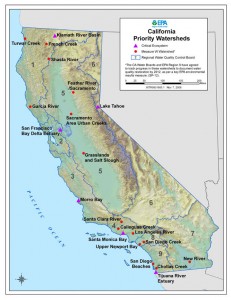What Are Watershed Basins ?

Watershed basins (Watersheds) are geographic areas bounded by topographic features which drain surface water from rain, snow, and ice melt to lower-elevation natural or man-made collection points such as a wetlands, streams, rivers, lakes, estuaries, and dams. The Department of Water Resources divides California into 10 major watershed basins (hydrologic regions ), which have multiple sub-basins (planning areas ), and 431 groundwater aquifer basins which underlie 40% of the state. California receives an average of 200 million acre-feet of precipitation annually, of which 35% reaches rivers in its 10 watershed basins and about one-third of this flow reaches the Pacific Ocean.
How Are Watersheds Protected From Pollution ?
Surface water transports nutrients, sediment, fertilizers, pesticides, herbicides, and other pollutants which affect a watershed’s ecology. As part of the Clean Water Act, the Environmental Protection Agency adopted the National Pollution Discharge Elimination System program in 1981 to stop pollutants generated by human activities from reaching the waters of the United States. NPDES requires that all municipal, industrial and commercial facilities which discharge storm water from point sources (e.g., pipes, ditches, channels) obtain either an individual or general permit. In California, Regional Water Quality Boards issue NPDES permits, except for Native American tribal lands which are regulated by the EPA. California produces about one-half of America’s fruits, nuts and vegetables. Agricultural runoff from irrigation, subsurface tile drains, and storm water transports pesticides, herbicides, sediment, nutrients, salts (including selenium and boron), pathogens, and heavy metals. Agricultural discharges are regulated by the Irrigated Lands Regulatory Program through Waste Discharge Requirements issued by the 9 Regional Water Quality Boards for 40,000 growers and 6,000,000 acres.
Construction Sites and Improved Land
Runoff from construction sites and improved land (e.g., roofs, parking lots, roads) are under the jurisdiction of the EPA’s NPDES program, which is regulated in California by the 9 Regional Water Quality Control Boards. Water Boards issue Municipal Regional Permits in urban areas to counties and Joint Powers Authorities, which are responsible for enforcing local NPDES regulations.
All construction projects regardless of size and all completed projects which have created or replaced impervious surfaces exceeding a threshold aggregate area (currently, 2,500 sq. ft.) must use Best Management Practices to detain storm water runoff and filter pollutants, especially sediment, before being discharged to an off-site storm drainage system (e.g., catch basins, drainage ditches, creeks). On construction sites, temporary BMP measures include silt fences, fiber rolls (wattles), truck tire wash-down, sediment traps, flocculants, geotextiles, and soil stockpile tarping. On completed projects (improved land), permanent BMP measures include permeable paving, mechanical sediment filters, and landscaping bio-filtration – NPDES General Permit, Appendix C, Part 3 (“C.3”). In general, interior remodeling projects and routine maintenance or repair projects such as reroofing or pavement resurfacing are exempt from C.3 storm water requirements.
Stormwater Pollution Prevention Plan
In addition to using BMPs, construction projects which disturb (e.g., removing vegetation, grading, excavation) a threshold level of ground surface (currently, 1 acre) must have a Storm Water Pollution Prevention Plan (SWPPP or “swip”) prepared by a Qualified SWPPP Developer (QSD) and monitored by a Qualified SWPPP Practitioner (QSP). A SWPPP identifies potential sources of pollution on the jobsite and describes the BMP methods which will be used during construction to reduce or prevent discharges of the pollution, including:

- Stormwater collection and discharge points
- Topography before and after construction and drainage patterns across the project
- Visual monitoring program and chemical monitoring program for “non-visible” pollutants should BMPs fail.
In addition to having a SWPPP, construction projects which are subject to the California Environmental Quality Act must have a Construction Management Plan which includes the implementation details for all construction-related Conditions of Approval. Post-construction permanent BMPs must be designed by a QSD and periodically inspected by the enforcing agency to assure proper maintenance.
Check the Links below and your local jurisdiction’s website for additional information.
Links
BUILDING in CALIFORNIA
-
Stormwater Harvesting with Underground Concrete Tank for Landscape Subsoil Irrigation
- Stormwater Harvesting
- Stormwater Harvesting with Above Ground Tank & Indoor Use
CalTrans
- The best site for designing and explaining storm water treatment
measures. It also includes spreadsheet calculators to assist in designing
complete storm water site treatment. Different approaches are animated and
clarifies different systems. Patience may be required to allow complete
loading, but once it is cached, it will open quickly. It’s worth the wait. – from CalTrans
California Water Resources Control Board
- Irrigated Agricultural Land Program
- QSD Training Program for Licensed Professionals
- Construction Storm Water Program
California Stormwater Quality Association
Construction Site Best Management Practices
- Alameda County
- Los Angeles County
- CalTrans
- California Storm Water Quality Association
- Orange County
- San Diego County
- San Francisco County
- Santa Clara County
- Sacramento County
Construction Industry Compliance Assistance Center
US Environmental Protection Agency
Additional Links & Downloads:
- Alameda County Clean Water Program
- California Watershed Network
- Great Site for Water Management & Resources
- Low-Impact Development Application Guide – UrbanGreen
- Low-Impact Development Manual for Southern California
- Surf Your Watershed in CA – EPA
- Watershed Browser – CA Dept. of Conservation
- Santa-Clarita-GCP-PRESENTATION (permission of Joe Zucker and Hall & Foreman)
- It’s not from California, but it has some of the best Storm Water Treatment Measures that we’ve seen in an Urban Environment-NYC Storm water Guidelines